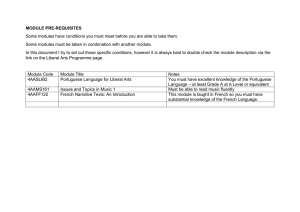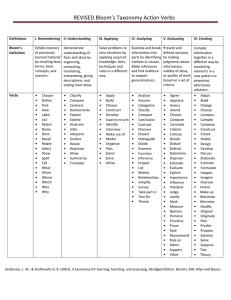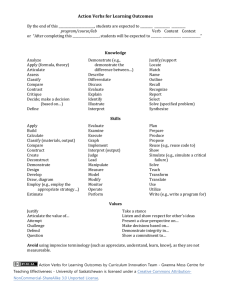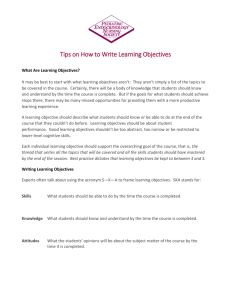Creating Learning Outcomes
advertisement
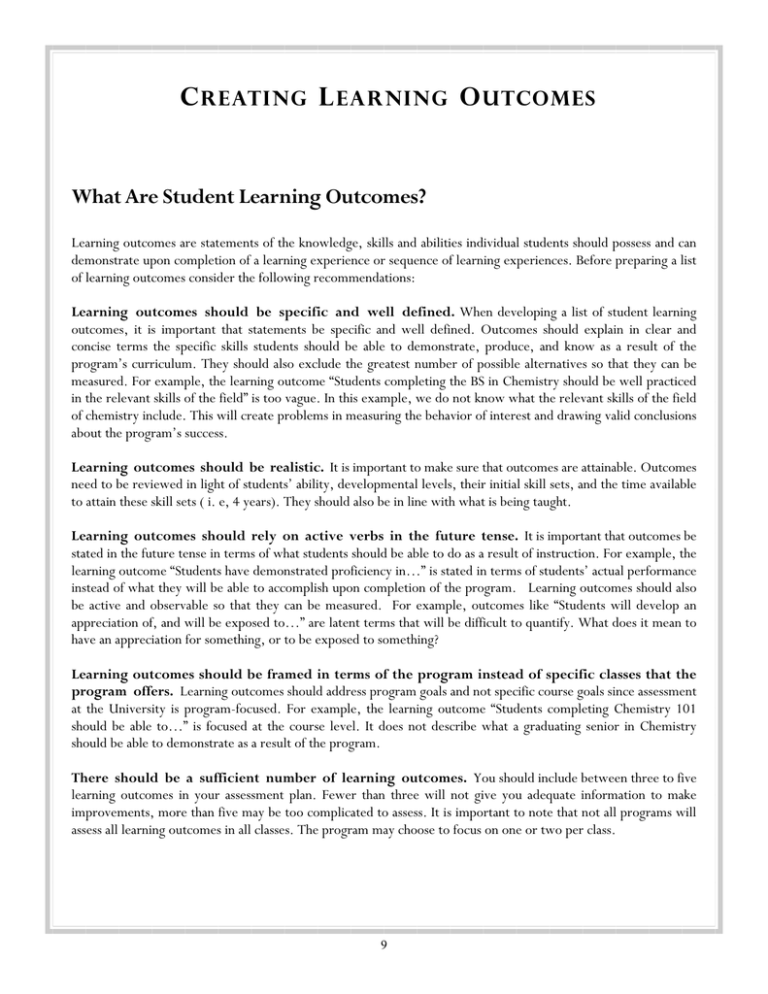
C REATING L EARNING O UTCOMES What Are Student Learning Outcomes? Learning outcomes are statements of the knowledge, skills and abilities individual students should possess and can demonstrate upon completion of a learning experience or sequence of learning experiences. Before preparing a list of learning outcomes consider the following recommendations: Learning outcomes should be specific and well defined. When developing a list of student learning outcomes, it is important that statements be specific and well defined. Outcomes should explain in clear and concise terms the specific skills students should be able to demonstrate, produce, and know as a result of the program’s curriculum. They should also exclude the greatest number of possible alternatives so that they can be measured. For example, the learning outcome “Students completing the BS in Chemistry should be well practiced in the relevant skills of the field” is too vague. In this example, we do not know what the relevant skills of the field of chemistry include. This will create problems in measuring the behavior of interest and drawing valid conclusions about the program’s success. Learning outcomes should be realistic. It is important to make sure that outcomes are attainable. Outcomes need to be reviewed in light of students’ ability, developmental levels, their initial skill sets, and the time available to attain these skill sets ( i. e, 4 years). They should also be in line with what is being taught. Learning outcomes should rely on active verbs in the future tense. It is important that outcomes be stated in the future tense in terms of what students should be able to do as a result of instruction. For example, the learning outcome “Students have demonstrated proficiency in…” is stated in terms of students’ actual performance instead of what they will be able to accomplish upon completion of the program. Learning outcomes should also be active and observable so that they can be measured. For example, outcomes like “Students will develop an appreciation of, and will be exposed to…” are latent terms that will be difficult to quantify. What does it mean to have an appreciation for something, or to be exposed to something? Learning outcomes should be framed in terms of the program instead of specific classes that the program offers. Learning outcomes should address program goals and not specific course goals since assessment at the University is program-focused. For example, the learning outcome “Students completing Chemistry 101 should be able to…” is focused at the course level. It does not describe what a graduating senior in Chemistry should be able to demonstrate as a result of the program. There should be a sufficient number of learning outcomes. You should include between three to five learning outcomes in your assessment plan. Fewer than three will not give you adequate information to make improvements, more than five may be too complicated to assess. It is important to note that not all programs will assess all learning outcomes in all classes. The program may choose to focus on one or two per class. 9 Learning outcomes should align with the program’s curriculum. The outcomes developed in your plan need to be consistent with the curriculum goals of the program in which they are taught. This is critical in the interpretation of your assessment results in terms of where changes in instruction should be made. Using curriculum mapping is one way to ensure that learning outcomes align with the curriculum. A curriculum map is a matrix in which learning outcomes are plotted against specific program courses. Learning outcomes are listed in the rows and courses in the columns. This matrix will help clarify the relationship between what you are assessing at the program level and what you are teaching in your courses. Learning outcomes should be simple and not compound. The outcomes stated in your plan should be clear and simple. Avoid the use of bundled or compound statements that join the elements of two or more outcomes into one statement. For example, the outcome “Students completing the BS in mathematics should be able to analyze and interpret data to produce meaningful conclusions and recommendations and explain statistics in writing” is a bundled statement. This outcome really addresses two separate goals, one about analyzing and interpreting data and another about writing. Learning outcomes should focus on learning products and not the learning process. Learning outcomes should be stated in terms of expected student performance and not on what faculty intend to do during instruction. The focus should be on the students and what they should be able to demonstrate or produce upon completion of the program. For example, the learning outcome “Introduces mathematical applications” is not appropriate because its focus is on instruction (the process) and not on the results of instruction (the product). STUDENT LEARNING EXPERIENCE (PROCESS) (Diagram adapted from Linn & Miller, 2005.) 10 LEARNING OUTCOME (PRODUCT) Constructing Learning Outcomes Considering Taxonomies Taxonomies of educational objectives can be consulted as useful guides for developing a comprehensive list of student outcomes. Taxonomies attempt to identify and classify all different types of learning. Their structure usually attempts to divide learning into thee types of domains (cognitive, affective, and behavioral) and then defines the level of performance for each domain. Cognitive outcomes describe what students should know. Affective outcomes describe what students should think. Behavioral outcomes describe what students should be able to perform or do. (Adapted from OAPA Handbook PROGRAM-Based Review and Assessment. UMass Amherst) Bloom’s Taxonomy of Educational Objectives (1956) is one traditional framework for structuring learning outcomes. Levels of performance for Bloom’s cognitive domain include knowledge, comprehension, application, analysis, synthesis, and evaluation. These categories are arranged in ascending order of cognitive complexity where evaluation represents the highest level. The table below presents a description of the levels of performance for Bloom’s cognitive domain. Level Description Knowledge To know and remember specific facts, terms concepts, principles or theories (represents the lowest level of learning) Comprehension To understand, interpret, compare, contrast, explain Application To apply knowledge to new situations to solve problems using required knowledge or skills Analysis To identify the organizational structure of something; to identify parts, relationships, and organizing principles Synthesis To create something, to integrate ideas into a solution, to propose an action plan, to formulate a new classification scheme Evaluation To judge the quality of something based on its adequacy, value, logic or use (represents the highest level of learning) Adapted from California State University, Bakersfield, PACT Outcomes Assessment Handbook (1999) 11 Using Power Verbs When composing learning outcomes, it is important to rely on concrete action verbs that specify a terminal, observable, and successful performance as opposed to passive verbs that are not observable. For example, the statements “be exposed to,” “be familiar with,” and “develop an appreciation of,” are not observable and would be difficult to quantify. The table below provides a list of common active verbs for each of Bloom’s performance levels. Knowledge Comprehension Application Analysis Synthesis Evaluation define/state classify apply analyze arrange appraise identify describe compute appraise assemble assess indicate discuss construct calculate collect choose know explain demonstrate categorize compose compare label express dramatize compare construct contrast list/label identify employ contrast create decide memorize locate give examples criticize design estimate name paraphrase illustrate debate formulate evaluate recall recognize interpret determine manage grade record report investigate diagram organize judge relate restate operate differentiate perform measure duplicate review organize distinguish plan rate select suggest practice examine prepare revise underline summarize predict experiment produce score tell translate inspect propose select argue translate cite inventory set up value critique sketch question articulate infer model interpret read distinguish assess solve perform criticize use solve collect test integrate defend Adapted from California State University, Bakersfield, PACT Outcomes Assessment Handbook (1999) Other Sources for Learning Outcomes When creating learning outcomes, it may also be helpful to consult professional organizations, similar programs at other universities, methods books, peer institution websites, or banks of learning outcomes on-line. It is also useful to develop ideas for student learning outcomes based on what students have accomplished in previous semesters. 12 Sample Learning Outcomes Languages and Literature: Students will be able to apply critical terms and methodology in completing a literary analysis following the conventions of standard written English. Students will be able to locate, apply and cite effective secondary materials in their own texts. Students will be able to analyze and interpret texts within the contexts they are written. French students will be able to demonstrate oral competence with suitable accuracy in pronunciation, vocabulary, and language fluency. French students will be able to produce written work that is substantive, organized, and grammatically accurate. French students will be able to accurately read and translate French texts. Humanities and Fine Arts: Students will be able to demonstrate fluency with formal vocabulary, artistic techniques and procedures of twodimensional and three-dimensional art practice. Students will demonstrate in-depth knowledge of artistic periods used to interpret works of art including the historical, social and philosophical contexts . Students will be able to critique and analyze works of art and visual objects . Students will be able to identify musical elements, take them down at dictation, and perform them at sight. Students will be able to communicate both orally and verbally about music of all genres and styles in a clear and articulate manner. Students will be able to perform a variety of memorized songs from a standard of at least two foreign languages. Students will be able to apply performance theory in the analysis and evaluation of performances and texts. Students will be able to analyze and interpret scripts. Students will demonstrate in-dept knowledge and understanding of contemporary theatre forms and artists. Students will be able to demonstrate proficiency in a variety of dance styles, including ballet, modern dance, jazz, and tap. 13 Sample Learning Outcomes Physical and Biological Sciences: Students will be able to demonstrate an understanding of core knowledge in biochemistry and molecular biology. Students will be able to apply critical thinking and analytical skills to solve scientific data sets. Students will be able to apply the scientific method to solve problems. Students will be able to demonstrate written, visual, and/or oral presentation skills to communicate scientific knowledge. Students will be able to acquire and synthesize scientific information from a variety of sources. Students will be able to apply techniques and instrumentation to solve problems. Mathematics: Students will be able to translate problems for treatment within a symbolic system. Students will be able to articulate the rules that govern a symbolic system. Students will be able apply algorithmic techniques to solve problems and obtain valid solutions. Students will be able to judge the reasonableness of obtained solutions. Social Sciences: Students will be able to write clearly and persuasively to communicate their scientific ideas clearly. Students will be able to test hypotheses and draw correct inferences using quantitative analysis. Students will be able to evaluate theory and critique research within the discipline. Business: Students will be able to work in groups and be part of an effective team. Students will be able to communicate business knowledge both orally and written. Students will be able to recognize and respond appropriately to an ethical and regulatory dilemma. Students will be able to recognize and diagnose accounting problems. Students will demonstrate disciplinary competence in a field of business. (NOTE: These samples were gathered from a variety of sources including UR assessment plans, program assessment statements at other institutions, etc.) 14 Using A Curriculum Map After you have developed the learning outcomes for your program, you should use a curriculum map to see how the outcomes you have developed are met in each course in the program. A curriculum map is simply a matrix in which you list each learning outcome in the rows and the program courses in the columns to indicate which courses contribute to each learning outcome. In each cell, place a letter to indicate how the course relates to the learning outcome. Use the letters “I,” “R,’ and “E” to designate which courses in the program “introduce,” “reinforce,” or “emphasize” the corresponding learning outcomes. By completing the curriculum maps, you can check for unnecessary redundancies, inconsistencies, misalignments, weaknesses and gaps in your learning outcomes. For example, the curriculum map below reveals that the 4th learning outcome is not addressed by any of the courses in the Engineering program. To correct for this a course could be redesigned to include this outcome or the outcome could be eliminated from the program. COURSE NUMBER LEARNING OUTCOME ENG 101 ENG 203 ENG 305 Outcome 1 I E R R R Outcome 2 I E R R R R R Outcome 3 Problem: Learning Outcome 4 is not met in any of the courses listed on the curriculum map. ENG ENG 425 498 E Outcome 4 Outcome 5 E We recommend developing a curriculum map as a group exercise with your program faculty to facilitate faculty discussion about the program’s learning priorities. The curriculum map will also illustrate how well your curriculum aligns with the specified outcomes. You can also use it to help design your assessment plan (e.g., which courses you might sample students from or administer assessment to). It will also provide a reference that may assist in interpreting assessment results later and in determining where you might make modifications in the curriculum. 15 Group Exercise to Create Learning Outcomes INSTRUCTIONS: Have a group of faculty members in your program complete this exercise. At the end of this process, you should be able to summarize and articulate 3-5 learning outcomes for your program’s assessment plan. Step 1 Start with a discussion describing what the “perfect student” graduating from your program should be able to demonstrate, represent, or produce. Step 2 Have each faculty member write down 3-5 learning outcome statements and use the checklist located on page 21 to evaluate them. Step 3 Conduct a panel discussion about your learning outcomes using a facilitator. Combine all criteria on to one list and have each member anonymously rank the outcomes as being very, somewhat, or not important. Discuss the results with your faculty and repeat the process until consensus is reached. Step 4 Map learning outcome statements to courses in the program to ensure educational coherence using the matrix on the following page. This will ensure that every student in your program has sufficient opportunity to achieve every outcome. Step 5 List your final set of leaning outcomes and have faculty use the checklist to make any last changes. 16 17 Use these codes under each course as appropriate: I=Introduce in course; R=Reinforce; E=Emphasize LEARNING OUTCOME COURSE NUMBER Use this map to verify if your program outcomes are in line with your program’s current educational curriculum. This activity will serve as a road map for writing learning outcomes as well as assist you later in interpreting assessment results and making program improvements. Curriculum Map 18 I I Students will demonstrate advanced oral proficiency in Portuguese. Students will demonstrate advanced reading proficiency in Portuguese. I I R PR 221 I R R E PR 305 E PR 301 E PR 402 R E R R PR 320 R R R R ILS 411 COURSE NUMBER R R R R ILS 423 R R R R ILS 453 E R R R ILS 498 PR 121: Beginning Portuguese; PR 221: Intermediate Portuguese; PR 305: Advanced Portuguese Grammar and Composition; PR 301: Beginning Portuguese Conversation; PR 402: Advanced Portuguese Conversation; PR 320: Introduction to Portuguese Literature; AS 411: Modern Portugal; AS 423: Art, Culture and Power in Latin America; AS 453: Advanced Studies in Iberian and Latin American Studies; PR 498: Senior Seminar for Portuguese Majors NOTE: Since these course numbers are made up, we are including course titles here for your reference. You do not need to include course titles on your curriculum map. You can enter the courses in whatever order makes the most sense for your program. You should include courses taught outside your department if they are part of the major. Students will be able to analyze and interpret written works in a historical and cultural context. I PR 121 Students will demonstrate their command of written Portuguese, in an advanced level with few errors in grammar, syntax, and semantics. LEARNING OUTCOME Sample Completed Curriculum Map Adapted from Maki (2004) LEARNING OUTCOME Once you have developed your learning outcomes, use this checklist to verify that our learning outcomes are complete. List your learning outcomes in the first column and then evaluate each outcome by placing a check mark in the appropriate boxes for each outcome. Learning Outcomes Checklist Can be directly measured and observed Maps directly to curriculum Focuses on student learning outcomes and not teaching activity Relies on action verbs in future tense Is useful to identify areas to improve Describes what students are intended to do, know, produce 19
